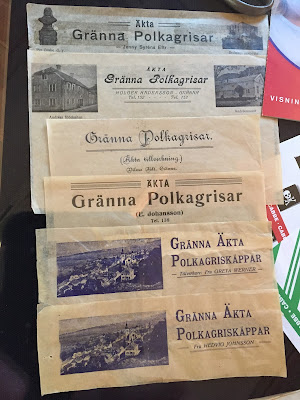After a steep climb next
to lake Vättern, I stop for a well-deserved lunch in Gränna, home of the candy
cane. But first, I decide to investigate who actually invented it. I therefore
turn to Marie Lundberg at Grenna Museum, to help me sort this out.
– Our museum is mostly
about Andrée Expedition, but the Gränna inhabitants more or less demanded
Amalia to have her own exhibition here at the museum.
The Amalia she refers
to is Amalia Eriksson – inventor of the candy cane and perhaps Sweden’s first
female entrepreneur.
– At least she was very
early, but perhaps also the first one.
Amalia’s husband died in
dysentery only four days after Amalia gave birth to twins. Only one of them
survived. Amalia now had to provide for herself and her daughter Ida.
– During the 1800s, women were still excluded from the business sector, but could be allowed to be self-employed for social reasons. Amalia therefore applied to the register office to "pursue bakery handling of coarser and finer varieties, for instance the so-called ‘polkagris’”. Thankfully, this was a different time than today.
Polkagris is the Swedish word for candy cane, and directly translated it means “polka pig”.
– “Polka” comes from the at-the-time popular dance, and “gris” means “sweet treat”. This was something you gave your beloved one during a dance, hence the word. In the certificate, it says “polkagris” in citation marks, which indicates that the word did not really exist up until then. We believe she made the word up.Amalia began baking her sweet candy on demand, and the business started growing. For the money, she bought a house and had around 2 MSEK in today’s money on her bank account.– It was tough, being a widow at those times, but she actually made a fortune of her invention. And later on, her daughter Ida took over the business.
Polkagris is the Swedish word for candy cane, and directly translated it means “polka pig”.
– “Polka” comes from the at-the-time popular dance, and “gris” means “sweet treat”. This was something you gave your beloved one during a dance, hence the word. In the certificate, it says “polkagris” in citation marks, which indicates that the word did not really exist up until then. We believe she made the word up.Amalia began baking her sweet candy on demand, and the business started growing. For the money, she bought a house and had around 2 MSEK in today’s money on her bank account.– It was tough, being a widow at those times, but she actually made a fortune of her invention. And later on, her daughter Ida took over the business.
I tell Marie about the
Google Doodle that was made in her honor on her 190th birthday, and that I was
part of creating it.
– Oh, was that you? We
were wondering where it came from. We posted it on our Facebook page. It is
really fun whenever Amalia is acknowledged.
I explain I have to bike away but first I take the time to gear up with som polka pigs, of course.











No comments:
Post a Comment